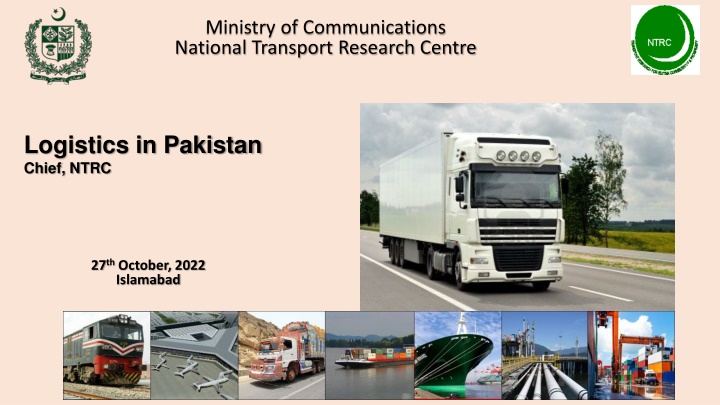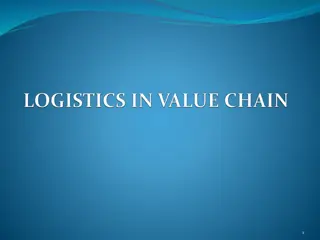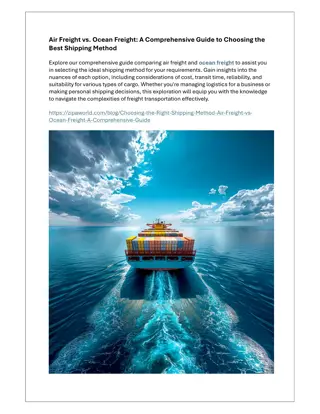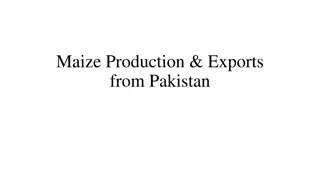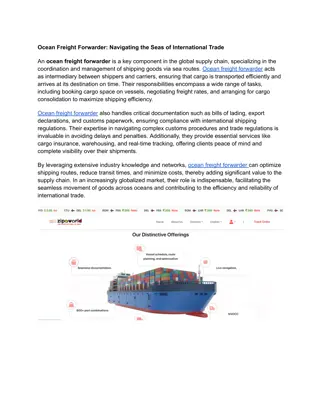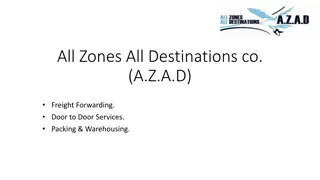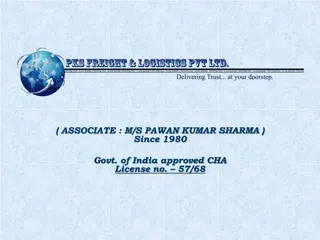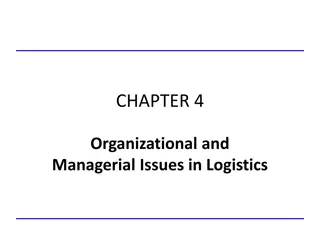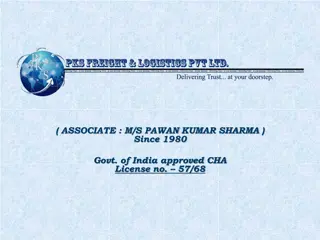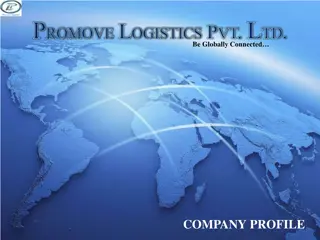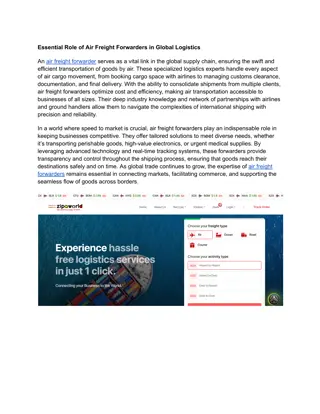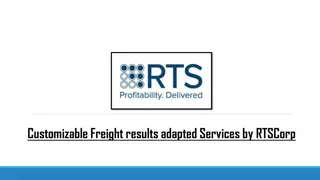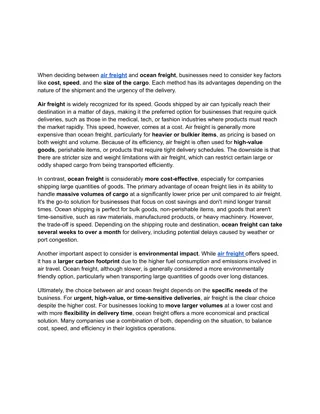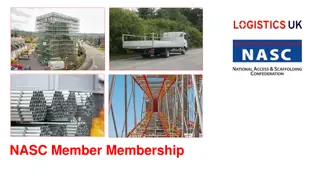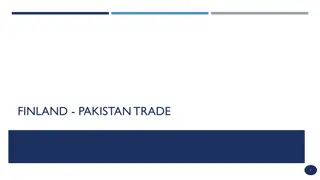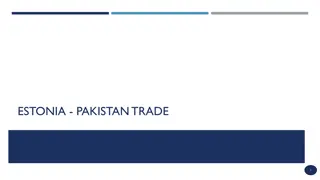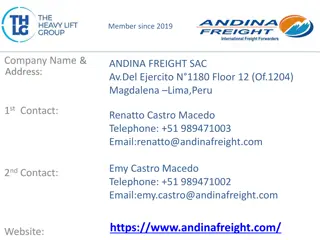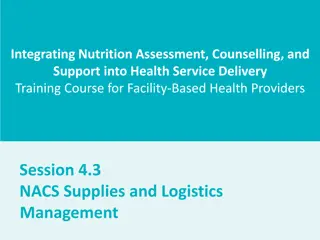Challenges and Opportunities in Pakistan's Freight and Logistics Sector
The National Transport Research Centre in Pakistan is focusing on the logistics sector to enhance the country's competitiveness. The National Freight & Logistics Policy aims to address various challenges such as an outdated truck fleet, bottlenecks in port access, and outdated transport laws. Efforts are being made to improve road safety, fuel efficiency, and streamline operations to meet global standards. The sector plays a crucial role in Pakistan's economy, contributing significantly to GDP and job creation. Modernization and harmonization of regulations are crucial for the sector's growth, especially with the development of the CPEC corridor and Pakistan's accession to TIR.
Download Presentation

Please find below an Image/Link to download the presentation.
The content on the website is provided AS IS for your information and personal use only. It may not be sold, licensed, or shared on other websites without obtaining consent from the author.If you encounter any issues during the download, it is possible that the publisher has removed the file from their server.
You are allowed to download the files provided on this website for personal or commercial use, subject to the condition that they are used lawfully. All files are the property of their respective owners.
The content on the website is provided AS IS for your information and personal use only. It may not be sold, licensed, or shared on other websites without obtaining consent from the author.
E N D
Presentation Transcript
Ministry of Communications National Transport Research Centre Logistics in Pakistan Chief, NTRC 27th October, 2022 Islamabad
Sequence 1. National Freight & Logistics Policy 2. Transport Sector
LOGISTICS According to the Council of Supply Chain Management, Logistics is that part of supply chain management that plans, implements and controls the efficient, effective forward and reverse flow and storage of goods, services and related information between the point of origin and the point of consumption in order to meet customers' requirements. (Council of Supply Chain Management, 2013) Logistics is the integration of transport, warehousing, freight forwarding, and information services. 4
LOGISTICS By directly improving competitiveness of products and services, efficient, smooth, and low-cost logistics services make a significant contribution to the economy and to people s livelihoods and national prosperity. Transport Sector contributes 13% of GDP & 5.4% of total jobs in Pakistan s economy Employment (Million) 30 24.7 24.57 24.27 25 20 15 10 4.2 4.2 4.15 3.1 3.1 5 2.8 0 2012-13 2013-14 2014-15 Transport Construction Agriculture
STRUCTURE of the POLICY 1 Introduction 2 State of the Pakistan s Freight and Logistics Sector 3 Justification for the NFLP 4 Vision, Principles and Objectives 5 Policy Actions 6 Implementation, Monitoring and Evaluation
ROAD TRANSPORT SECTOR Major Impediments A largely obsolete truck fleet: Causes problems of road safety (drivers are poorly trained) Has poor fuel efficiency (transport consumes 35% of all energy in Pakistan) Promotes overloading which damages roads Does not meet certification requirements under TIR and cannot be used to transport goods across borders Physical and non-physical bottlenecks Port access in Karachi and Port Qasim are an issue Rail is virtually non-existent Laws governing transport sector need updating and harmonization Carriage of Goods by Road Act (COGRA), was prepared in 2003 but never approved Trucking Policy of 2008 identified the need for change in the sector, but was partially adopted Legal environment in which sector operates needs to be updated to permit operations in line with standard practices globally Development of CPEC corridor, Accession to TIR will increase competition pressure on Pakistan s freight and logistic sectors 7
Core Transportation Modalities (Road, Rail, Maritime) Procedural Policy Infrastructure Road-side facilities / resting areas Weight-Bridges Bonded warehouse for imported vehicles Revise Trucking Policy 2007 Provincial Motor Vehicle Ordinance 1965 Tyres, lubricants, fuels Axle Load Regime Road Consignment Note Registration of Drivers Registration of heavy vehicles Road Extend operating hours Market-driven tariffs ML-1 Havelian Dry Port / KPK Rail-seaport connectivity Rail-SEZ connectivity Railways Laws 1890 PR Freight Transportation Company Rail Expand roles and mandates of KPT and PQA to include investment and training Future concessions to consider shipping alliances Incentives for industries development at Gwadar Gate Controls Over-sized/over-weight cargoes Adoption of FIATA FBL and FWB New access road to SAPT Barge solution for Karachi- Qasim transfer in future Relocate logistics facilities to Northern Bypass New access road to SAPT Second Channel for Qasim Toll solutions on passengers traffic for flyovers Maritime
IMPLEMENTATION OF THE NATIONAL FREIGHT AND LOGISTICS POLICY Ministry of Communications leading on the implementations. NFLP Steering Committee and Working Group with private sector representation guided the progress of implementation. Logistics Performance Indicators to confirm Monitoring and Evaluation. Statistics collected and published by the National Transport Data Observatory and Pakistan Bureau of Statistics
ROLE OF TRANSPORT SECTOR Transport allows people to access jobs, markets, social interaction, education, and other services, thus enabling people to rise out of poverty and overcome social exclusion. Transport adds value to goods brought to markets, links rural areas to cities and global supply chains, driving economic development. Enhanced national integration of the country. Cultural integration. A well functioning Transport Sector is a pre-requisite for country s development. Transport is a key driver of socioeconomic development. 11
SUB - SECTORS Roads Railway Aviation Ports & Shipping Inland water 12
TRANSPORT ASSETS Number of Vehicles Total Roads -- 31.0 million -- 500,748 Km Motorways -- 2471 Km National Highways -- 11,321 Km Provincial Road Network -- 487,362km Rail Tracks -- 7,791 km Railway Locomotives -- Total 470 (458 Diesel & 12 Steam Engines). Airports -- 7 major airports handling passengers & cargo Dry Ports -- 15 dry ports/ border terminals Sea Ports -- 3 commercial sea ports 13 Source: Bureau of Statistic
ROAD DATA COMPARISON UNIT 1947 2021 30,968,000 + REGD VEHICLES NO 30,577 REGD TRUCKS/TRAILERS NO 800 300,000+ 500,000+ TOTAL ROADS KM 50,367 MOTORWAYS KM NIL 2500+ NATIONAL HIGHWAYS KM NIL 12,000 Total area of Pakistan KM2 - 862,069 ROAD DENSITY KM/KM 0.06 0.58 14
ROAD LENGTH Total: 500,748 KM 373,525 400,000 350,000 300,000 250,000 200,000 150,000 87,764 100,000 21,672 50,000 10,500 4,388 2,471 428 77 0 1 Motorways Expressway National Highways Highways Primary Road Secondary Roads Local Road Metro Road Primary Road 4,388 Secondary Roads 87,764 Motorways Expressway National Highways Highways Local Road Metro Road 2,471 428 10,500 21,672 373,525 77 Total 15 Source: NTRC Digital Maps
ROAD LENGTH Total: 500,748 KM 300000 250000 200000 Road Length (km) 150000 100000 50000 0 Federally Administered Tribal Areas Fata Islamabad Capital Territory Azad Jammu And Kashmir Gilgit Baltistan Khyber Pakhtunkhwa Balochistan Punjab Sindh Total 10656 45724 13012 6419 6287 45963 281196 92167 16 Source: NTRC Digital Maps
VEHICLES ON ROAD Summary of Motor Vehicles on Road in Pakistan Motorcy cle/ Motor Ricksha w 4 Jeep / D.Cabi n Buses / Mini Bus Mcy / Scooter Motor Car M.Cab / Taxi Station Wagon Ambu Oil D.Van Pickup Truck Tractor Tanker Other Total -lance 1 2 3 5 6 7 8 9 10 11 12 13 15 16 2016-17 11,975,304 204,200 176,400 69,582 201,900 5,700 156,300 276,200 1,430,100 14,843 6,954,000 197,400 122,000 74,700 21,858,629 2017-18 14,060,885 210,100 187,200 80,000 206,600 6,900 159,224 280,000 1,460,200 15,200 7,183,500 197,711 128,100 92,400 24,268,020 2018-19 21,268,750 212,368 498,067 143,645 209,976 8,330 162,552 610,717 20,300 283,100 3,813,200 205,296 638,100 301,910 28,376,311 2019-20 22,808,822 139,861 513,485 150,892 93,100 8,780 193,715 627,993 24,331 287,150 3,960,188 116,107 721,290 309,600 29,955,314 2020-21 23,701,800 141,350 521,650 155,200 91,315 9,100 165,000 636,000 22,000 289,100 4,048,700 116,500 767,700 313,300 30,978,715 Source: * Excise & Taxation Department, Motor Registration Authority of all provinces. NTRC has complited, computerized and disiminated the said information.
NATIONAL TRANSPORT POLICY The nation s transport vision is to provide safe, affordable, efficient, durable, and environmentally friendly means of transport, ensuring reliable access to jobs, markets, education, and other services for all. NTP - 2018 18
TRANSPORT MODAL SHARE IN PAKISTAN 2020 In Billion Year Vehicle - km Passenger - Km Ton-Km Total Total By Road By Rail Total By Road By Rail 1995 16 145 75 2000 18 150 80 2005 20 155 99 2010 28 200 135 2015 35 235 150 2020 50 295 94% 6% 195 95% 5% 2025 62 363 91% 9% 230 86% 14% 2030 77 442 90% 10% 290 78% 22%
100 95 90 90 Freight Traffic 80 Passenger Traffic 70 TRANSPORT MODAL SHARE IN PAKISTAN 60 94% 95% % 50 100 90 40 80 Passenger Traffic 0.5 70 Freight Traffic 30 60 % 50 20 8 40 30 2 6% 0 3% 10 20 2% 0% 10 0 0 ROAD RAIL AIR ROAD RAIL
